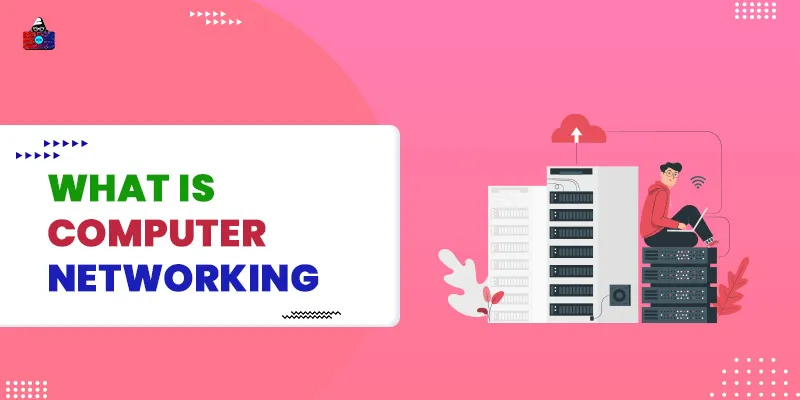Computers have become an essential part of our day-to-day life, and it is important to know their basics. Nowadays, computers are used in almost every sector, ranging from the IT sector to the agriculture sector. For any business or company to survive and thrive in this modern world, it is important for them to make the best use of various technologies and follow the latest tech trends. One such technology that business entities should focus on is computer networking.
Here, in this blog, we have addressed the basics of computer networking, its components, and major terms that you should be aware of.
What is Computer Networking? [Definition]
A computer network is the interconnection of several computers, like computers, laptops, and mobile phones, which communicate and share information with each other. The process of forming and managing computer networks is called computer networking. In today’s world, millions of computers are interconnected through networks to share information related to everything and anything.
The growth of the internet is also one of the major reasons for the need for computer networking because it is useful for every category of people, like businessmen, students, and artisans.
Types of Computer Networking
The four different forms of computer networks are as follows:
1. Local Area Network (LAN)
If you are using a Computer Network in a Cafe, house, computer lab of a school or college, or a building of a company, then you might be using a LAN connection. As the name itself defines it, this type of network takes up a minimal area or region. Interestingly, a LAN connection at a house or small building is called SOHO LAN, i.e., a Small Home Office Local Area Network. There are very few connections in such a network, and usually, it makes use of devices like routers or switches.
2. Metropolitan Area Network (MAN)
This type of network covers a greater ground area than a LAN, but its coverage is not as large as a WAN. It lies somewhere near the midpoint in the stretch of LAN and WAN. It can connect more devices than a LAN as it covers a larger area. Moreover, MAN also connects a series of LANs together to form a larger network. Many network routers are used to segregate and integrate a proper network under MAN. It also requires more frequent checks than LAN due to a larger network connection.
3. Wide Area Network (WAN)
WAN is the largest network possible, and it can spread across thousands of hectares of ground area. It can cover nations and states and helps to connect and transport all the important details. It uses many networking devices like switches, hubs, repeaters, routers, and more. WAN connections demand continuous checking and administration. If any network crashes, there can be severe consequences. The Internet is the best example of WAN.
4. Virtual Local Area Network (VLAN)
VLAN separates a LAN. Although it is one network, it looks like a different network.. This type of computer network can be achieved with the help of switches.
6 Different Network Devices
1. Router
The router is a device that connects two or more LANs and helps to determine the path of the data that is to be sent or received through a network. The router works as a three-layer device and lies in the third layer of the OSI model. It uses IP addresses as a medium.
2. Switch
A switch works as a layer two device and falls in the second layer of the OSI communication model. A switch is the backbone of the LAN system which interconnects devices and is a better version of the bridge.
3. Wireless Router
Wireless routers are widely used in homes and offices to connect several devices like mobile phones, laptops, computers, etc. Devices do not require any kind of wires to connect with a wireless router, and the network is commonly known as a Wi-Fi network.
4. Access Point
An access point is considered to be a replacement for a switch. It is a device that forms a WLAN or Wireless LAN in an office, school, or other building. On one end, it has to be connected to a router, switch, or hub using a network cable to project a Wi-Fi signal in a particular area.
5. Hub
A Hub is a type of repeater but an improved version of it and is known as a multiport repeater. It can connect computers and share information as well.
6. Ethernet
Ethernet is a system that allows the creation of a local area network (LAN) using network cables, also known as Ethernet cables. These cables allow computers to connect with other network devices and also facilitate computer-to-computer connections.
Important Terms Associated with Computer Network
1. IP Address
IP, in literal terms, means Internet Protocol. The IP address of every device is unique and is a 32-bit address given to every computer, mobile phone, laptop, etc., to trace them with ease. It has 2 versions, namely IPv4 and IPv6 .
- IPv4: It is the most common IP address version and is a combination of numbers. This version consists of 12 numbers separated into four parts of 3 digits, each with the help of a dot. For example, 192.168.231.254
- IPv6: This version is relatively new and is a combination of alphabets and numbers. It has 32 determinants that are divided into 8 parts, with each part having 4 determinants and separated by a dot. An example of an IPv6 address is 2031:0000:130F:0000:0000:09C0:876A:130B
2. MAC
A media Access Control address (MAC) is a 64-bit address unique to every electronic device. This address is assigned to every computer, mobile phone, laptop, etc., during manufacturing. It helps to easily recognize the devices and is unique.
3. Subnet Mask
The subnet mask helps to determine the class of an IP address which is assigned to every electronic device alongside the IP address to determine the IP address’s class or network.
- To recognize class A IP address – subnet mask is written as 255.0.0.0
- To recognize class B IP address – subnet mask is written as 255.255.0.0
- To recognize class C IP address – subnet mask is written as 255.255.255.0
4. Domain Name Service
DNS translates and transforms easily readable names into different IP addresses and transforms the IP addresses into easily readable names. To see how to resolve the IP addresses, you can check out the DNS record lookup.
5. Wi-Fi
A wireless connection is a boon in every way. It is a way of connecting networks and computers without using wires or cables of any kind. Moreover, it supports wireless networks such as computers that are compatible with Wi-Fi, wireless routers, and more.
OSI Model
It is a seven-layer model which acts as a standard for communication between devices and networks. Here’s a brief overview of each layer of the OSI model:
1. Physical Layer
The physical layer allows transmitting data from the physical layer of sending device to the physical layer of receiving device. This layer usually includes physical resources like hubs, modems, repeaters, cables, and network adapters.
2. Data Link Layer
The Data Link Layer allows you to transfer data from one node to another directly. It also corrects any errors that might have occurred in the physical layer. This layer of the OSI model has two sub-layers: MAC and LLC.
3. Network Layer
This layer transfers or delivers frames received from the Data link layer to their assigned destination with the help of addresses contained inside the frames. Routers are an important element in this layer. They form a path for information to reach the designated address.
4. Transport Layer
This layer regulates the size, helps in the delivery, and checks data packets for errors. It works with size, sequence, and transfer of data between networks and hosts. Transmission Control Protocol (TCP) is an example of the transport layer.
5. Session Layer
At this particular layer, the connection between machines is set up, managed, and determined. This layer controls connections between different computers. Also, the Session layer takes care of processes like authentication and reconnection.
6. Presentation Layer
This layer formats and translates data with easy-to-understand syntax and semantics, which makes the application layer user-friendly. It is also known as the Syntax layer. Moreover, it handles encryption and decryption that the Application layer might require.
7. Application Layer
This is the final layer, where the end-user and application layer interacts with the help of software. The layer looks after the network services that the end user requires. The application layer determines the identification of communication allies, resource availability, and communication synchronization.
Conclusion
After all, this being said, these are the basics that everyone needs to be aware of in this high-tech network-savvy era. Computer networks like LAN, WAN, MAN, VLAN, and then the OSI Communication Model are just the tip of the iceberg in computer networking. There is still so much more than this that can be explored and understood if you need to go in-depth into computer networking. There is not enough space to suffice so much information in one blog as this field carries.
People are also reading:



![What is TCP/IP Model? [Definition, Working, & Layers]](/media/new_post_images/TCP_IP_Model.webp)

Leave a Comment on this Post